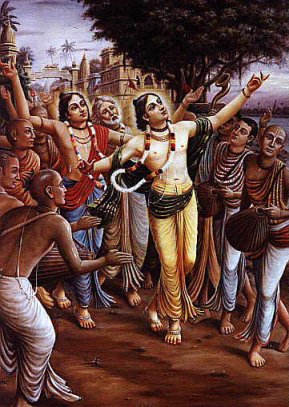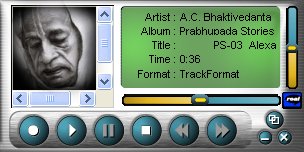|
|
|||
|
Not long ago, on a relaxed Sunday afternoon, a wonderful Jagannatha Ratha-yatra festival was held in Leicester. Local devotees were joined by others from Birmingham, Coventry and elsewhere. The Lord Mayor of Leicester gave a speech, after which he swept the road ahead with a golden handled broom. Everyone joined together enthusiastically to pull the ropes of the chariot. Festooned with flowers and with its giant canopy billowing in the wind, the brightly painted chariot of Lord Jagannatha, the Lord of the Universe, trundled down Melton road and Belgrave road to Cossington Park, where, under a large marquee, an afternoon of kirtan, bhajans, dance and drama had been planned for the pleasure of the Lord. The drama, which was performed by children and young people, concerned Sri Chaitanya Mahaprabhu’s arrival in the town of Jagannatha Puri shortly after He had taken sannyasa, the renounced order of life. This event took place almost five hundred years ago. In His home town of Navadvip, Sri Chaitanya Mahaprabhu had revealed to His intimate devotees that He was the Supreme Personality of Godhead, Lord Sri Krishna Himself, and by means of the mass congregational chanting of the Hare Krishna mantra (Hare Krishna Hare Krishna Krishna Krishna Hare Hare, Hare Rama Hare Rama Rama Rama Hare Hare), He had attracted thousands to the exclusive devotional service of Lord Sri Krishna. Now that He was a renounced sannyasi, Sri Chaitanya Mahaprabhu was obliged to leave His place of birth, but in Jagannatha Puri He was virtually unknown. In the opening scene, Lord Chaitanya, accompanied by His companions Nityananda Prabhu and Mukunda Datta, arrived on the outskirts of Jagannatha Puri, within sight of the summit of the Jagannatha temple. Lord Chaitanya became ecstatic as He anticipated His first sight of the Deity of Lord Jagannatha, and He ran ahead, leaving the others behind. The second scene took us inside the temple of the Lord of the Universe. Present in the temple was Sarvabhauma Bhattacharya, the chief pandit in the court of the Maharaja of Orissa and the most revered scholar in Jagannatha Puri. Loudly chanting the glories of Lord Jagannatha, Lord Chaitanya entered the temple, but on seeing the beautiful form of the Lord He became stunned, His voice faltered, and, losing external consciousness, He fainted to the ground. A temple guard raised a stick intending to beat the Lord, but Sarvabhauma Bhattacharya intervened. Although he was an impersonalist and had no faith in devotional service to the Personality of Godhead, Sarvabhauma was nevertheless well versed in many scriptures, and he could understand that the transformations he had witnessed in the body of Sri Chaitanya Mahaprabhu were due to ecstatic spiritual emotions. Sarvabhauma Bhattacharya had Lord Chaitanya brought to his own house. Sri Chaitanya Mahaprabhu’s breathing was very shallow, but by the use of cotton threads Sarvabhauma was able to detect the passage of air through the Lord’s nostrils. In this way many hours passed. Eventually Sri Chaitanya Mahaprabhu’s companions arrived at Sarvabhauma Bhattacharya’s house, and by loudly chanting the Hare Krishna mantra, Nityananda Prabhu brought the Lord back to external consciousness. The Lord then led His companions in a tumultuous kirtan, the congregational chanting of the holy names of Lord Krishna. Sarvabhauma Bhattacharya objected to Lord Chaitanya’s kirtan, and he told this to his brother-in-law, Gopinatha Acharya. “This is definitely not the business of a sannyasi! As a sannyasi Sri Chaitanya should be absorbed in the study of Vedanta, not foolishly singing and dancing!” A heated debate then ensued, for Gopinatha Acharya had previously lived in Navadvip and had become a staunch follower of Lord Chaitanya. Gopinatha Acharya quoted verses from the ancient Vedic scriptures that proved Sri Chaitanya Mahaprabhu to be the Supreme Personality of Godhead. For instance, in the Srimad-Bhagavatam (11.5.32) it is said: krsna-varnam
tvisakrsnam sangopangastra-parsadam “In the age of Kali (the present age of quarrel and hypocrisy) intelligent persons perform congregational chanting to worship the incarnation of Godhead who constantly sings the names of Krishna. Although His complexion is not blackish, He is Krishna Himself.” Next, Gopinatha Acharya quoted a verse from the Mahabharata: suvarna-varno
hemango varangas
candanangadi “The Lord will appear with a golden complexion, and His beautifully constructed body will resemble molten gold. Sandalwood pulp will be smeared over His body. He will take the sannyasa order, and will be self-controlled. He will be fixed in devotional service, and will spread the chanting of the holy names.” Sarvabhauma Bhattacharya had no faith in these statements of the scriptures, but he admitted to his brother-in-law that he had a fatherly affection for Sri Chaitanya Mahaprabhu. He announced his intention to teach Sri Chaitanya Mahaprabhu Vedic scriptural knowledge, and expressed his fear that without such knowledge Sri Chaitanya could easily become allured by material temptations and might not be able to uphold His sannyasa vows. |
Becoming upset on hearing these words, Gopinatha Acharya told Sarvabhauma, “You consider yourself the knower of all Vedic scriptures…but only when the Lord becomes pleased with you will you understand scriptural conclusions.” Lord Chaitanya, however, humbly conceded to Sarvabhauma Bhattacharya’s request, and for seven days the two met in the Jagannatha temple. Sarvabhauma Bhattacharya’s teachings on the Vedic scriptures were based on the discipline of logic, every Sanskrit word being exposed to severe grammatical analysis. In this there was no place for bhakti, loving devotion to Lord Sri Krishna, for the conclusions reached by such study excluded the conception of the Godhead having personality. Sarvabhauma taught that the ultimate goal, after conquering all one’s desires, is to merge into the impersonal, all-pervading oneness of the undifferentiated Brahman. Sri Chaitanya Mahaprabhu sat quietly, without response. On the eighth day Sarvabhauma Bhattacharya could no longer tolerate the Lord’s silence. “You are hearing again and again, yet You keep silent. I cannot understand what is actually within Your mind!” The Lord then began to speak. “The Vedic scriptures, compiled by the sage Vyasadeva, are self-evident, and are as radiant as the sun. One who tries to interpret its meaning simply covers that sunshine with a cloud. For each verse the direct meaning must be accepted without interpretation. However, you simply abandon the direct meaning and proceed with your imaginative interpretation…” Sri Chaitanya Mahaprabhu explained that, according to the Vedic scriptures, the Supreme Absolute Truth is a person, the Supreme Personality of Godhead, full with all opulences. The Supreme Lord is described as being ‘sac-cid-ananda-vigraha’, which means that He has a transcendental body that is eternal, fully conscious with complete knowledge, and full of bliss. The impersonal Brahman is merely the effulgence that emanates from the body of the Lord, and thus this aspect of the Absolute Truth is secondary to His personal feature. The Lord is the master of all spiritual potencies, and the living entity is the servant of them. That is the difference between the Lord and the living entity. The scriptures, therefore, never support the conception that the Absolute Truth is formless, nor that the Lord and the living entities are one. As the Lord spoke, Sarvabhauma Bhattacharya presented unlimited opposition. However, Sri Chaitanya Mahaprabhu refuted all these arguments and established His own conviction. Gradually Sarvabhauma lost faith in him-self and became baffled. Lastly, the Lord explained the famous ‘atmarama’ verse to Sarvabhauma (Srimad-Bhagavatam 1.7.10): “Those who are self-satisfied and are not attracted by external material desires, are nevertheless attracted to the loving service of Sri Krishna, whose qualities are transcendental and whose activities are wonderful. Hari, the Personality of Godhead, is called Krishna because He has such transcendentally attractive features.” Hearing the Lord’s explanations, Sarvabhauma was struck with wonder. Then he recalled how Gopinatha Acharya had said that Sri Chaitanya Mahaprabhu was not a human being, and he thought, “Chaitanya is certainly Lord Krishna Himself.” As Sarvabhauma denounced himself as an offender and took shelter of the Lord, the Lord desired to show him mercy. Thus Sri Chaitanya Mahaprabhu revealed to Sarvabhauma His form as Lord Sri Krishna. By the mercy of the Lord, all truths were revealed to Sarvabhauma Bhattacharya, and he could understand the importance of chanting the holy name and distributing love of Godhead everywhere. He prayed to Lord Chaitanya, “My dear Lord, You have easily delivered the entire world, but what is amazing is that You have also delivered me. I had become dull-headed by reading too many books on logic, and had become like an iron bar. But You have melted me, and therefore Your influence is very great.” Sarvabhauma’s life became transformed. He later told, “In the association of the jackals known as logicians, I simply barked continuously, making a resounding ‘bhieu, bhieu!’ Now, from the same mouth, I am chanting the holy names ‘Krishna!’ and ‘Hari!’” The whole town of Jagannatha Puri became amazed to see how Sarvabhauma Bhattacharya, together with his disciples, had become a follower of Sri Chaitanya Mahaprabhu, and thus the Lord’s fame spread ever wider. Sarvabhauma Bhattacharya wrote many songs and verses glorifying Sri Chaitanya Mahaprabhu, including a famous book of one hundred verses known as the ‘Sarvabhauma Sataka’. One famous verse written by Sarvabhauma Bhattacharya states: vairagya-vidya-nija-bhakti-yoga- “Let me take shelter of the Supreme Personality of Godhead, Sri Krishna, who has descended in the form of Lord Chaitanya Mahaprabhu to teach us real knowledge, His devotional service and detachment from whatever does not foster Krishna consciousness. He has descended because He is an ocean of mercy. Let me surrender unto His lotus feet.”
Anyone who is interested in the life and teachings of Lord Chaitanya should read ‘The Teachings of Lord Chaitanya’, by His Divine Grace A.C.Bhaktivedanta Swami Prabhupada, published by the Bhaktivedanta Book Trust, or the multi volume biography of Lord Chaitanya entitled ‘Sri Caitanya Caritamrta’, also by His Divine Grace A.C.Bhaktivedanta Swami Prabhupada and published by the Bhaktivedanta Book Trust. |
||
|
|
click here for Children's Pictures to this Article
Home
|
Newsletter
|
Harmonium Lessons
|
Hot News
|
Real Audio Page
Copyright © 2005-2007 Hare Krishna Centre for Vedic Studies (Leicester) Hare Krishna Hare Krishna Krishna Krishna Hare Hare ::: Hare Rama Hara Rama Rama Rama Hare Hare |
||


